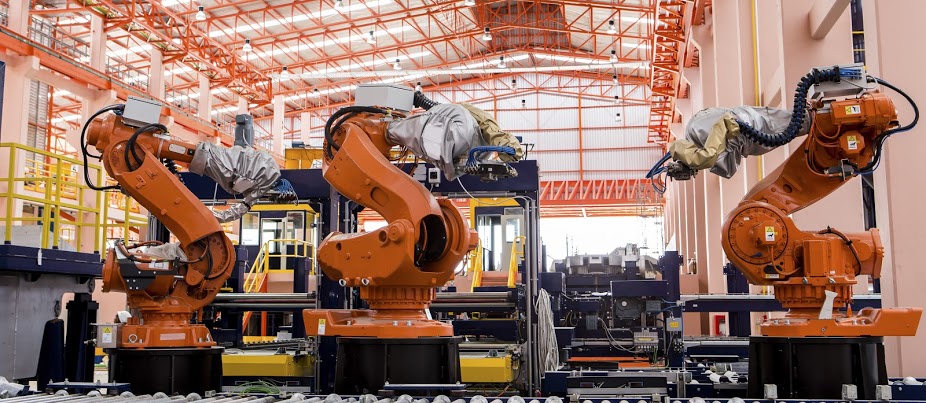
News
Is Ontario still a manufacturing powerhouse?
The Trillium Network for Advanced Manufacturing welcomes efforts to raise awareness and engage in dialogue about the state of Ontario’s manufacturing sector.
We appreciate the perspectives offered by the host and panelists on the December 4th episode of TVO’s The Agenda. This episode asked the question: is Ontario still a manufacturing powerhouse? The answer is: absolutely.
The panelists included Linda Hasenfratz, the CEO of Linamar, one of Canada’s largest and fastest-growing manufacturers, and Wayne Lewchuk, Professor Emeritus of Economics and Labour Studies at McMaster University (and the supervisor of our own Brendan Sweeney’s undergraduate thesis). Hasenfratz and Lewchuk provided diverging perspectives, and in the spirit of open and respectful dialogue, we comment on some of these perspectives in this blog post.
The first few minutes of the episode examined manufacturing job losses in the 1970s and 1980s, the increase in the 1990s, and the subsequent decreases over the past two decades. While there is no question that Ontario’s manufacturing sector has changed since the 1990s, these data fail to tell the entire story. Manufacturing employment has decreased about 25% since 2000. However, productivity is up 18%.[1] While the quantity of manufacturing jobs may have diminished, the quality has improved.
While the quantity of manufacturing jobs may have diminished, the quality has improved.
Further unpacking these trends is important. Manufacturing is not a monolithic endeavour, and informed dialogue should not treat it as such. This was evident when Hasenfratz astutely cautioned about having one’s ‘head in the oven and feet in the freezer’ when making broad conclusions based on averages for the entirety of manufacturing. While Ontario lost certain manufacturing capabilities over the last two decades, it also made significant gains. Ontario’s manufacturing ecosystem remains among the most diversified in North America, as Trillium Network for Advanced Manufacturing research published earlier this year shows.
Ontario’s manufacturing ecosystem remains among the most diversified in North America.
It is true that Ontario has sustained some losses in output. The most noticeable of these came as the result of automotive assembly and powertrain manufacturing plant closures in several southern Ontario communities. These losses are also related to the rapid growth of the automotive industry in low-wage jurisdictions (e.g. Mexico). Yet recent investment announcements by the five Original Equipment Manufacturers (OEMs) with operations in Ontario suggest a bright future for the automotive industry. Perhaps the most significant difference here, when compared to the late 1990s, is that Toyota now holds the title of the largest vehicle manufacturer in Canada. As Lewchuk noted, Toyota is the most recent OEM to build an assembly plant in Canada. In proportional terms, however, the most significant reductions in output over the past two decades did not occur in the automotive industry, but rather in tobacco processing, electronics, furniture, and pulp and paper.[2]
Ontario’s manufacturing sector has also made significant gains since 2000. The production of both pharmaceutical products and medical supplies more than doubled. Encouraging further investment in these industries is critical to the health and economic well-being of the province. Most segments of Ontario’s food and beverage processing have grown, as have Ontario’s non-automotive transportation equipment industries, including aerospace. Several categories of industrial machinery manufacturing has also grown and are poised to play leading roles in developing made-in-Ontario solutions to productivity challenges. While these are by no means zero-sum replacements for reduced output and employment in the automotive, tobacco, electronics, and furniture manufacturing industries, they are evidence that Ontario remains a competitive jurisdiction for manufacturing investment.[3]
Hasenfratz made another good point about the intersections between manufacturing and technology. Intersections between manufacturing and information and communications technology (ICT) exist throughout the province–especially in Ottawa and Waterloo. Similar intersections are also evident between manufacturing and agri-food, mining, and construction. First, most of Ontario’s crops and livestock are destined for modern and efficient processing facilities. Second, Sudbury, the home of the third panelist, Tom Fortin, and his company Ontrak Control Systems, is the centre of an extensive network of mining equipment and technology manufacturers. These manufacturers play an important role in supporting a safe and productive mining industry in the province. Third, a substantial portion of Ontario’s manufacturing sector produces materials and technologies used in the construction of buildings and infrastructure. The symbiotic relationship between manufacturing and these other industries is an important part of Ontario’s economy. While manufacturing accounts for 12 percent of Ontario’s GDP (and a much larger proportion of private sector output) and nearly $200 billion of exports (79% of the province’s total), it’s impact extends far beyond the factory floor.[4]
It would be more productive to focus our attention on leveraging the diverse manufacturing base that already exists and identifying potential intersections between manufacturers and potential customers, suppliers, and R&D partners.
This dialogue is welcome and valuable. However, rather than lamenting the loss of cigarette and blue jean factories, perhaps it would be more productive to focus our attention on leveraging the diverse manufacturing base that already exists and identifying potential intersections between manufacturers and potential customers, suppliers, and R&D partners. As a quick glance at TrilliumGIS – our flagship asset- and capability-mapping platform – illustrates, manufacturing remains a critical component of Ontario’s economy, society, and individual communities from Kenora to Cornwall and Windsor to Cochrane. This is unlikely to change anytime soon.
For more information contact:
Brendan Sweeney, PhD
Managing Director
Trillium Network for Advanced Manufacturing
m: 905.807.2548
Sources
[1] Source: Author’s Calculations, Statistics Canada, Tables 36-10-0402-01 and 14-10-0202-01.
[2] Source: Statistics Canada, 36-10-0402-01.
[3] Source: Statistics Canada, 36-10-0402-01.
[4] Source: ISED, Trade Data Online.
